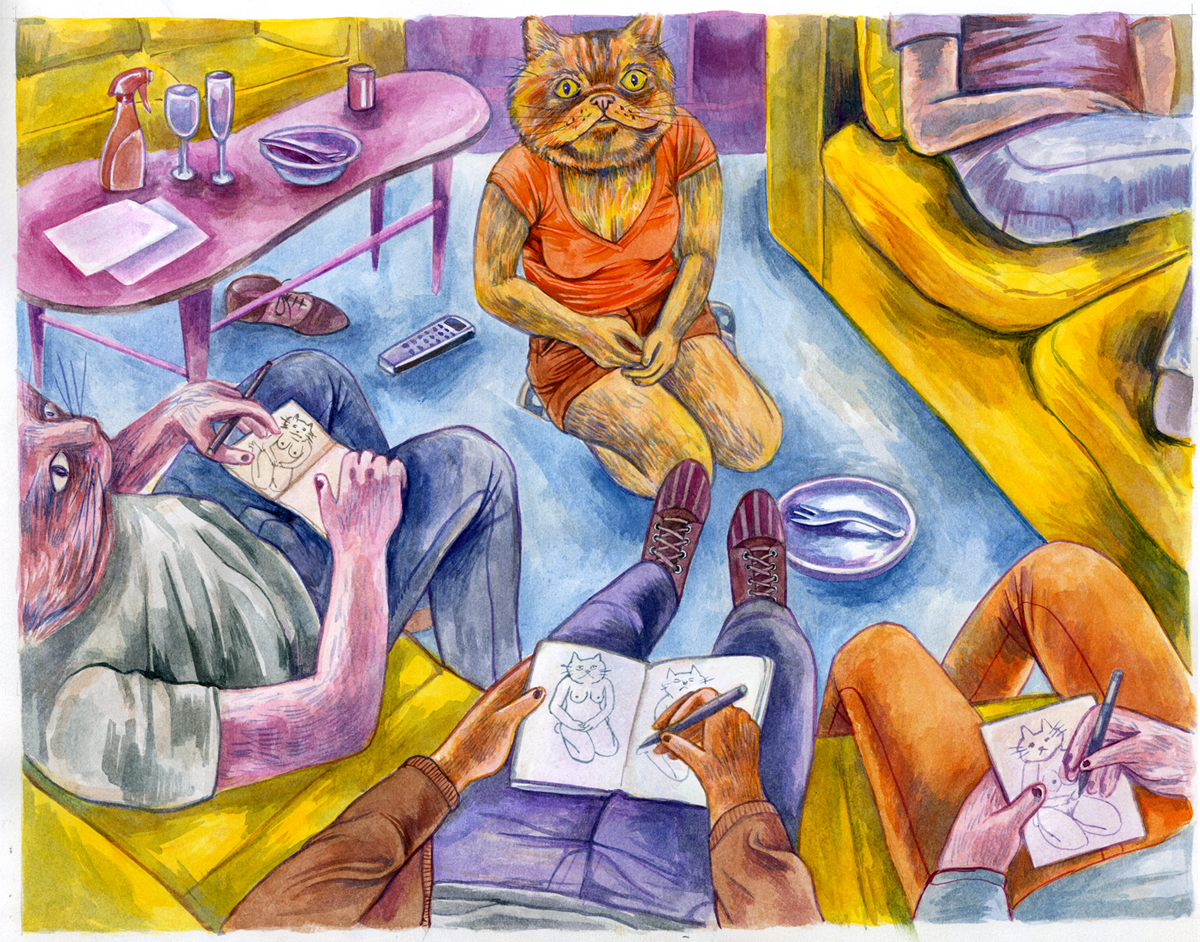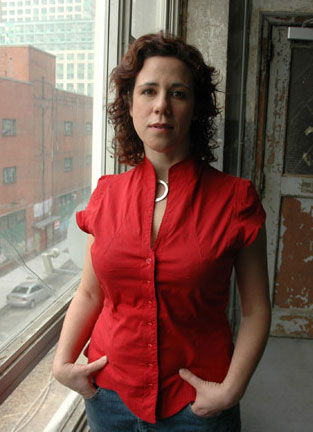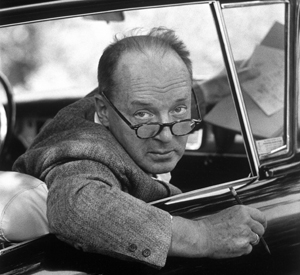Lisa Hanawalt is most recently the author of My Dirty Dumb Eyes. Please note the prefatory reading contains wild and rambunctious horse noises to simulate accompanying images in audio form.
Listen: Play in new window | Download
Author: Lisa Hanawalt
Subjects Discussed: Language that perplexes Planet of the Apes aficionados, revolting against natural euphony, being a native Californian, San Francisco Bay Area people who end up in Brooklyn, Alternative Press Expo, Buenaventura Press, how UCLA grooms its art students, immersing yourself in the comics scene, the disadvantages of hyphenates, drawing animal humanoid figures, being a “horse girl,” the best horse sounds, interspecies relationships, childhood notions of marriage, crawling around on all fours, having parents as scientists, taxonomic qualities in genotypes, the inspirational qualities of illustrated guides, the single comic strip as batty syllogism, unlimited space, The Vow, “based on a true story,” scribbling notes after seeing a movie, War Horse, imagining that you’re a horse, venturing into surrealistic realms to get into personal truths, Hanawalt not drawing herself, Julia Wertz, how voice translates generic labels, artists who lean too much on pop culture, the horrors of Slate Culture Gabfest, recap culture, the artistic response as a way to avoid pop culture trappings, Hanawalt’s toy fair report, why the tangible and the physical is more rewarding than the pop cultural, going into a war zone, Sarah Glidden, Israel, being shy around strangers, David Foster Wallace, the comics answer to the footnote, the animalized person as a form of armor, ribald sexuality, wedding registries, seeking permission to draw friends within pieces, varieties of “in vino veritas,” art professors who are obsessive about faces, teachers who are too nice, sculpting, dogs who bark once a day, taking a break from two-dimensional work, visual cues from movies and visual cues from comics, having friends who are comics, the toy company pecking order, why power structures are interesting, commenting upon politics, the advantages of presenting yourself as an idiot, the New York Times‘s veto of “butt turkey,” restrictions from family newspapers, balancing artistic integrity and paying the rent, being read comics by her dad, not leaving the house, living in Greenpoint, shifting from hating to loving New York, anxieties about public transportation, the hermetic seal of a car, the use of colors to enhance personal stories, the unsettling nature of sickly blues, the pristine look of Apple advertisements, white space, enhancing Ryan Gosling’s costume in Drive, deepening visual observations with the sartorial, the pleasant sounds of dogs lapping at water, Roger Corman’s Twitter presence, judging people from what they wear, paying attention to men’s clothing, best dressed cartoonists, how Jason Diamond dresses, Johnny Negron, how people get offended by everything, feeling like you’re on display for putting yourself out there, blocking people, the appeal of lines, silly statistics, the New York approval matrix, and infographics as the perfect joke structure.
EXCERPT FROM SHOW:
Correspondent: I wanted to ask you about the title. Because in light of the Planet of the Apes story you have in this, I kept thinking that your title was My Damn Dirty Eyes.
Hanawalt: (laughs)
Correspondent: It’s like you deliberately designed a title to make Planet of the Apes fans, to just throw them off. I’m not sure if that was conscious.
Hanawalt: I didn’t even think about that until now. You just blew my mind. I didn’t think about that.
Correspondent: Especially since there’s the Rise of the Planet of the Apes review. And I was thinking…
Hanawalt: And that’s something I say to my boyfriend. I call him, “You damn dirty ape!” Whenever he’s doing anything.
Correspondent: So you generally say “my dumb dirty” instead of “my dirty dumb”? How did that get swipped? Swapped?
Hanawalt: It’s Dirty Dumb, right?
Correspondent: Yes, it’s Dirty Dumb.
Hanawalt: I actually tried it both ways and I just liked the way “dirty dumb” sounded. I thought “dumb dirty” is the more natural way to say it. But I just like…it sounded like a musical. Dirty Dumb. Dirty Dumb. I don’t know.
Correspondent: You were revolting against natural euphony, basically.
Hanawalt: Yeah. I guess so. People keep switching them in reviews and stuff.
Correspondent: I was determined to get it right.
Hanawalt: Thank you. I appreciate it.
Correspondent: So you went to UCLA. And I’m a fellow Californian.
Hanawalt: Oh!
Correspondent: Although I was a northern Californian and you were a southern Californian.
Hanawalt: No, I”m from northern California originally.
Correspondent: You are!
Hanawalt: Yes.
Correspondent: Where were you at?
Hanawalt: Palo Alto.
Correspondent: Palo Alto! Oh my god, I was born in Santa Clara.
Hanawalt: Whoa.
Correspondent: So we’re Bay Areaites.
Hanawalt: Yup.
Correspondent: So how did we both end up in Brooklyn? You first. Actually, you only. (laughs)
Hanawalt: (laughs) Me only. Well, I met my boyfriend. So that was big.
Correspondent: Oh! Well, I met a girl too. Oh my god.
Hanawalt: It’s a good reason to move.
Correspondent: How did we not run into each other until now?
Hanawalt: I don’t know. But that was not the official reason I moved for a long time. Just in case it didn’t work out. I didn’t want to say that. So I said it was to become part of a more vibrant comics community in Brooklyn, for more people of my age making comics here.
Correspondent: How did we not run into each other at Alternative Press Expo?
Hanawalt: I’ve been there.
Correspondent: I’ve been there multiple times. I covered it. I would go and I would interview everybody. Every person with minicomics there.
Hanawalt: Really? I used to go every year.
Correspondent: I went every year too. And I miss it. It was great.
Hanawalt: I would table with Buenaventura when I was there. I think I went 2008, 2009.
Correspondent: Yeah. Just a little after I did.
Hanawalt: We just missed each other.
Correspondent: We just missed each other. Well, now we’re talking.
Hanawalt: (laughs)
Correspondent: So you went to UCLA.
Hanawalt: Yes.
Correspondent: And you wanted to become a part of a comics community? Is that how you ended up in Greenpoint?
Hanawalt: Eventually. When I was at UCLA, I thought I wanted to be like a studio artist. Like an actual gallery painter. And that’s what they were sort of grooming me to be. But I guess once I graduated and didn’t immediately become a famous painter with solo shows in Chelsea, I was like, “Oh, I guess I’ll keep making these comics that I make at Kinko’s and write with my friends. Then eventually I got more into the comics scene as I started going to conventions and I met my first publisher.
Correspondent: So it was really kind of an accidental existence going into…
Hanawalt: Yeah, it was.
Correspondent: I read one interview where you said you didn’t feel that you were a cartoonist.
Hanawalt: Oh really? Did I?
Correspondent: Yes. You said that in 2010.
Hanawalt: Oh, I guess I changed my mind about it.
Correspondent: You are officially a cartoonist.
Hanawalt: Yeah, I do. You know, I make comics. If people ask me if I’m an artist, an illustrator, or a cartoonist, I say that I’m all three. And depending on my mood, I’ll introduce myself as one of the three.
Correspondent: And you can’t just call yourself a hyphenate or something.
Hanawalt: No, it’s just too complicated. And at that point, people — their eyes start to wander and they lose interest in talking with me. So….(laughs)
Correspondent: So what was the first animal humanoid figure that you ever drew? I was curious about that. They’re throughout your work. And I’m wondering when you started putting, say, lizard heads on regular people or pop cultural figures. Things like that.
Hanawalt: I started drawing cats as people when I was like five or six. And I was drawing myself. What I wanted to be when I grew up was a black cat that was also a human who wore an orange Hawaiian shirt. Because I was really into Weird Al Yankovic at the time. So I would draw my self-portrait as a black kitty cat. And then later I started drawing horses as people. When I was like seven, eight.
Correspondent: I know you were a “horse girl.” What does that entail? Did you ride horses? Did you enact a life as a horse? Did you do a lot of horse sounds? “Neeeeeeeeeigh” and all that?
Hanawalt: Yeah. I was a cat girl until I took my first riding lesson at eight. And it set off a bomb in my brain. And I just was like “Horses! Horses! Horses! I want to marry a horse. I want to be a horse. I just want to…”
Correspondent: You want to marry a horse?
Hanawalt: Yes. I used to want to marry a horse. I asked my mom if I could and she was like, “Maybe that will be legal someday.” She had a very…
Correspondent: A lax view on bestiality.
Hanawalt: I guess.
Correspondent: Interspecies relations.
Hanawalt: I didn’t know at the time that marrying kind of meant that you were sexually partnered.
Correspondent: Oh, it was a more romantic image!
Hanawalt: Yeah. Yeah. I mean, I was only six or eight. And I just wanted to be linked with a horse forever.
Correspondent: It’s sort of that moment where you’re playing with Barbie and Ken in the Dreamhouse. Then all of a sudden you realize, “Oh! They’re actually going to have sex as well.”
Hanawalt: Yeah. You figure that part out later. But yeah, I made a lot of horse noises. I drew horses. I crawled around on all fours.
Correspondent: Do you make horse noises to this very day?
Hanawalt: I can make a snorting sound. [highly commendable snorting sound]
Correspondent: Oh! That’s pretty good.
(Loops for this program provided by HardstyleRythm, ShortBusMusic, and Reed1415.)
The Bat Segundo Show #502: Lisa Hanawalt (Download MP3)

 Correspondent: I’m wondering also about the Terri Schiavo narrative, because it does play in more later in the book than in the beginning of the book. Did you know immediately that there was this almost quasi-allegorical feel to that? Or did it start with the fact that you had Martin Miller in this coma?
Correspondent: I’m wondering also about the Terri Schiavo narrative, because it does play in more later in the book than in the beginning of the book. Did you know immediately that there was this almost quasi-allegorical feel to that? Or did it start with the fact that you had Martin Miller in this coma? Correspondent: Okay, well, if Davis and the donut girls was one of the key starting points, was this an imagined experience? Or was this drawn from anything specific that you observed? Because I am certainly not familiar with this phenomenon. (laughs)
Correspondent: Okay, well, if Davis and the donut girls was one of the key starting points, was this an imagined experience? Or was this drawn from anything specific that you observed? Because I am certainly not familiar with this phenomenon. (laughs) Correspondent: Going back to this issue of topography as a launching point, it’s reminiscent to me of Nabokov’s rule, where he basically said that he could not write a novel until he actually had a particular location. Likewise, in addition to this inspirational momentum, I wanted to first of all find out if this was a factor for you in terms of writing this. And it also leads into another question about Jarvis’s perspective, where she’s generally taking a small item and putting it into a larger neighborhood. For example, there’s a pack of cigarettes she observes. And she’s very clear in the way that she describes it as coming from a particular deli and how it was actually purchased and the like. So I wanted to ask you about this phenomenon. Was this a way for you to generate momentum in your book? You needed to get the lay of the land before the lay of the characters?
Correspondent: Going back to this issue of topography as a launching point, it’s reminiscent to me of Nabokov’s rule, where he basically said that he could not write a novel until he actually had a particular location. Likewise, in addition to this inspirational momentum, I wanted to first of all find out if this was a factor for you in terms of writing this. And it also leads into another question about Jarvis’s perspective, where she’s generally taking a small item and putting it into a larger neighborhood. For example, there’s a pack of cigarettes she observes. And she’s very clear in the way that she describes it as coming from a particular deli and how it was actually purchased and the like. So I wanted to ask you about this phenomenon. Was this a way for you to generate momentum in your book? You needed to get the lay of the land before the lay of the characters?